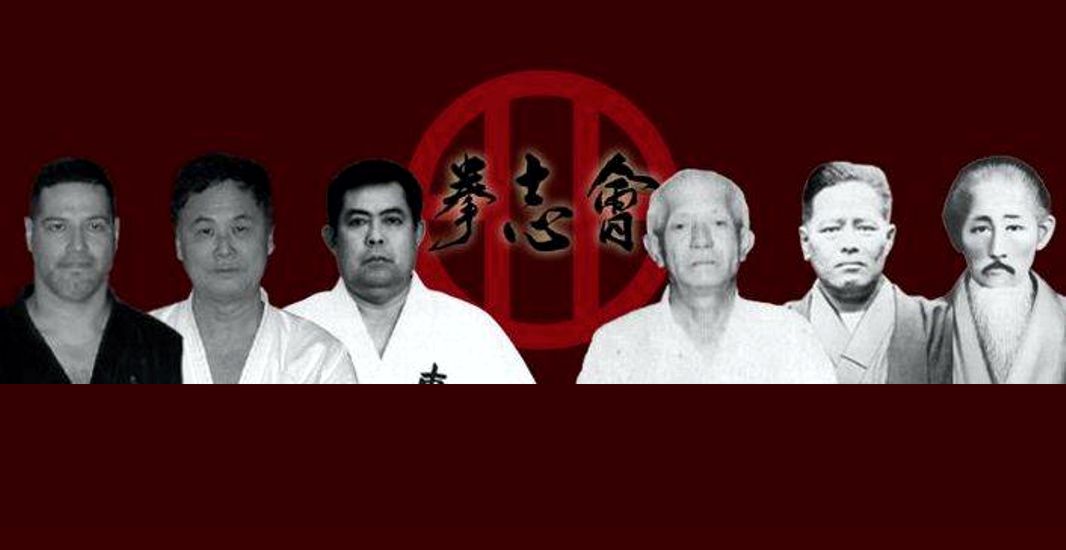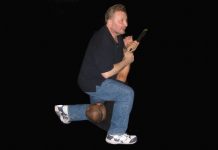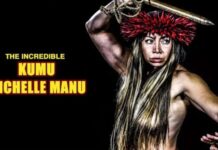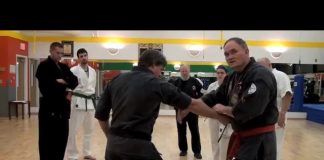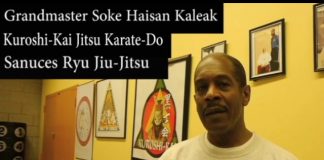Luis Morales Sensei, my sincere thanks to you for agreeing to take part in this interview. Being the US representative of the Kenshi-kai could you please tell us a little about the association and what it represents?
Morales: Hello, I am honored to do this interview.
The Kenshi-kai organization was created to preserve the teachings of great masters that Hokama Sensei learned from, as well as to promote Old Style Karate. The US Kenshi-Kai was created to preserve and spread old style Goju-Ryu and to protect Hokama Sensei’s interests here. Kenshi-Kai teaches a full curriculum including what I call the ‘Sub Arts’. So if you were to compare Kenshi-Kai to most other Goju-Ryu schools the difference between karate-do and karate-jutsu become apparent.
Brown: That sounds interesting! I’d like to go into more depth on some of those matters, but before we do I’d like to ask a little about your personal journey along ‘the path’ if I may. Maybe you would like to start by telling us when you started training and in what style that was?
Morales: First let me say that as a child I was fascinated with the martial arts, spending hours reading the various karate publications such as Black Belt Magazine and Karate Illustrated, I couldn’t wait for the next issues to come out. But my first real exposure to the Martial Arts came when I was about 8 years old when a family friend introduced me to a Ju-jutsu style called Miyama Ryu. I used to ask him to teach me but he would only demonstrate and would say that I was too young. But to answer your question, I started my formal training 35 years ago at the age of 12 in Tae Kwon Do. I did Tae kwon do for about 11 months and around that time I met my good friend Charles Valentin who invited me to come and train at his teacher’s dojo called Bronx Shotokan Karate Club in the South Bronx. The kumite was tough, all the local Karate competitors and thugs trained there. So I joined! Around the same time, I think it was about a month or two before, I had met Steve Hernandez who did Goju-Kai method and he started to teach me the basic Kata.
Brown:I must ask was the Bronx NY as notorious as what it is depicted on the TV? And did the environment affect your approach to your martial arts practice?
Morales: YES! Remember that in the 70’s the Bronx was full of gangs, so it was pretty tough especially when you live in a neighborhood where it was full of gang members, but it was home. It definitely affected my approach to the Martial Arts.
Brown: So all those films I’ve seen aren’t an exaggeration of life in the Bronx. It must certainly add a certain amount of intensity to your training, many of the martial fraternity live in fairly low risk areas and their training probably reflects that.
So you found Goju Kai with Steve Hernandez to your liking, what was it exactly about Goju that appealed to you?
Morales: I liked the breathing and the way they did kumite. Steve taught me Gekisai dai ichi, Ni, and Saifa then introduced me to one of his teachers; Teddy Wong Sensei who was a student of G. Yamamoto, a top student of Gogen Yamaguchi Hanshi and had also trained briefly with Sakiyama Sensei the Zen priest who trained with Miyagi Sensei. I trained with Wong Sensei for about a year and a half. Then Steve introduced me to Raymond Duran Sensei who was a Sandan under Gogen Yamaguchi but had left the Goju-kai and started doing the Shoreikan style of Goju-Ryu under Thomas Boddie. Sensei Duran was teaching Shoreikan, with Goju-Kai style Kumite. He had many good students who were good at kata and kumite. By that time I had just made shodan in Shotokan and stopped training in that style. I really fell in love with Goju-Ryu so I put all my effort in training and learning Goju-Ryu.
Brown: It certainly sounds as though Steve exposed you to a lot of quality instruction. You must have still been quite young, about 17? I know that when I was training at that sort of age I didn’t think a great deal about the what’s or the why’s I just got stuck in and done whatever was requested. How was your training in those early days with Sensei Duran?
Morales: Yes he did. I was young and hungry and sort of a perfectionist so I always asked questions. Sensei Duran training was good, lots of kumite, he had awesome kicks with great combination.
Brown: You said “teaching Shoreikan, with Goju-Kai style kumite”, is there a difference between Shoreikan and Goju-Kai kumite?
Morales: Shoreikan Goju-Ryu is Okinawan; they have two man sets for their kata and lots of prearranged sparring, which they call kiso kumite. Goju-kai is from Mainland Japan they tend to do a lot of jyu kumite but little or no bunkai.
Brown: How long were you with Sensei Duran?
Morales: I was with him a few years; he got disgusted with all the Karate politics and stopped teaching totally. But we would meet once in a while with Steve and go to the park and do “everything goes kumite” (no rules).
Brown: Karate politics are very detrimental to our art, shame that it drove Sensei Duran to quit teaching! So you were still with Steve, your original Goju Sensei for all this time you must’ve developed a good relationship with him by now. Where did Steve take your training after Sensei Duran?
Morales: I wasn’t with Steve as far as training goes, I don’t consider Steve my teacher, he has been more as a mentor than my sensei, still today he give me very good advise. By then I had made shodan under Steve and Duran.
I had a basement in the apartment building that I lived in and I would practice with friends from other styles. I also kept training and teaching a small group. I was so hungry for knowledge that I would research my art and try to find anyone who had knowledge on Goju-Ryu.
Brown: Were you still following the Goju-Kai/ Shoreikan way then or just any Goju that was available to you?
Morales: By then I was doing the Okinawan way with goju-kai type of sparring. I went to San Francisco to train with Gosei Yamaguchi for about three weeks. It was a great workout but I liked the Okinawan forms better and the kigu hojo undo.
Brown: I have read a lot about Gosei Yamaguchi what is his karate like?
Morales: He gave you a great workout with lots of sparring drills. I still have a set of notes of the sparring drills that he taught and I still use for sport Karate type of sparring.
Brown: And what was he like personally?
Morales: I didn’t get to know him well enough to comment on his character, so I have nothing negative to say about him. One thing that I can say is that he was in great shape.
Brown: So after training with Yamaguchi Sensei what was your regular training schedule like?
Morales: I trained everyday, I also bought every book and video that I could find about Goju-Ryu, and it was around that time I got a video of Taika Seiyu Oyata doing kata and bunkai. WOW! He totally changed my outlook on Karate and my training changed.
In March 1983 I went to Japan, I trained at the Goju-kai then went to Okinawa.
Brown: How long did you train in Japan?
Morales: I stayed about three weeks and then went to Okinawa for a week.
Brown: What was the training like with Goju-Kai?
Morales: I was not happy with the training. I was very disappointed.
Brown: All that build up only to be disappointed must have been quite an anti climax. So did you go to Okinawa hoping to find what you was looking for?
Morales: I was so impressed with what I had seen on the Oyata tape; I was trying to find a Goju-ryu teacher like him. So when I went to Okinawa I visited different dojos such as Shoreikan, Jundokan, and Shobukan etc. I didn’t see anyone like Oyata Hanshi. But out of the dojo that I visited I favored the Jundokan dojo, Miyazato Hanshi was a very nice man, he gave me Chinen Sensei’s address and told me to get in contact with him when I got back to the USA.
Brown: So you got in touch with Chinen Sensei upon your return to the USA?
Morales: I didn’t until about four years later; he was doing a seminar in the New York area so I went along to train. I fell in love with the way he performed Goju-ryu kata. I then went to Spokane Washington to his Annual gasshuku. The training was tough, and I really enjoyed it!
Brown: What was the outcome of your experience with Jundokan?
Morales: I eventually got invited to be a part of Chinen Sensei group. I had followed Chinen Sensei everywhere, if he was in Florida I was there, if his was in New Jersey I was there, I mean everywhere! I eventually became one of his senior students on the East Coast.
Brown: I’ve heard very good things of Chinen Sensei. I believe that he is very particular but also encourages you to develop as an individual.
Morales: I presume that you had graded with the Jundokan in this time, what grade did you achieve with them?
I hate to say this but Chinen sensei never encourages any of his student to help them in their self development as Karate practitioners.
Chinen sensei recognized me as a yondan when I joined his group. I was yondan for 12 years under him until Miyazato Hanshi awarded me godan but told me that I should be a higher grade. He said that if I came back to Okinawa the following year he would award me a higher grade.
Brown: Did you go back?
Morales: When I went back to Okinawa in late 1999 I didn’t go to the Jundokan, my Karate was going in a different direction; I went to train at the Kenshi-kai. I had met Hokama Hanshi in June 1999 and trained with him for one day, we talked about the so-called “secret” and I was impressed so much that I resigned from Jundokan!
Brown: And the so called “secret” is the secret of effective karate?
Morales: It helps a great deal 🙂
Brown: So one days instruction from Hokama Sensei was all it took to convince you that his way was the way you wanted to follow; he must’ve made quite an impact! What was it that convinced you that his way was the way you wished to pursue?
Morales: Actually, it was when I met him the first time that I was really impressed by him, then the next day I went to train with him. The first time I saw him was when he was giving me a tour of his Karate kobudo museum. I started to name the different photos of masters that he had on the wall and he said, “You know them? How?” I said that Karate is my life and that I read a lot etc. He then invited me to go down stairs to his dojo. He got tea and
Okinawan candy and we started to talk. I asked him about Kyusho-jutsu but he was reserved, then he asked me if I knew any.
Brown: And did you know?
Morales: I told him that I knew only a little. He asked for me to show him and called one of his students to uke for me and I showed him some Kyusho. Then Hokama Sensei got up and did a toe kick on him and the guy just dropped, he was out!
Brown: Cool! So was it Hokama Sensei’s knowledge of Kyusho that drew you to him or was it his complete understanding of Goju-ryu?
Morales: It was his complete understanding of Karate, and the way he did Goju-Ryu. It was Hard and Soft not just Hard. Hokama Hanshi answered so many questions that I had, questions that I was unable to get satisfactory answers to from my previous Goju-Ryu teachers.
In my humble opinion, he is the only one that I have seen that truly demonstrates the Go & Ju aspect of the system. He exemplifies the true essence of Goju-Ryu Karate.
Brown: That’s a very bold statement considering that you have trained with some very respected teachers in the past i.e. Miyazato and Chinen.
Morales: Yes it is.
Brown: I understand that Hokama Hanshi practices what is commonly referred to as Bubishi lineage or Seiko Higa lineage Goju-ryu. Is this different from other Goju-ryu?
Morales: I think only in certain groups it is referred to as Bubishi lineage. Seiko Higa kept a lot of the teachings from Kanryo Higaonna and Hokama sensei learnt from him and his top student Seiko Fukuchi. At Higa’s dojo Hokama sensei met Matayoshi Hanshi whom he learnt Kobudo from and Seiyu Nakasone who shared his theories on Karate.
Brown: I understand that Seiko Higa was a much smaller man than Chojun Miyagi and that he utilized the teachings of Kanryo Higashionna to a greater degree as a result. Is this true; was Miyagi’s Goju and Higa’s interpretation of Goju different?
Morales: In appearance I don’t think it was significantly different, I think more in theory and application.
Brown: Do you have any idea why the Bubishi has greater relevance to those of the Higa lineage?
Morales: I think it was because of Seiko Higa, he really studied the Bubishi. I asked my teacher why he has a deep understanding of Karate and he told me that when he was a student under Seiko Higa doing kata he was not convinced with the bunkai he was learning and kept pressing the issue, Higa eventually started to teach him the “good stuff” and then told him to study the Bubishi.
Brown: Is the Bubishi that Seiko Higa referred Hokama Sensei to anything like Patrick McCarthy’s translated version?
Morales: It maybe the same
Brown: What is so special about the Bubishi?
Morales: The Bubishi teaches body position and vital points, as well as herbal remedies.
Brown: Do you consider it important to study the Bubishi considering all the information that is widely available to us in today’s society?
Morales: I think it is important to study it since it is an old historical document, but you can get the same information today from other sources.
Brown: Ok we’ll come back to that later, but now I’d like to return to your early training with Hokama Sensei. How did you go about making the change from Jundokan to Kenshi-kai Goju?
Morales: When I joined Hokama Hanshi he never claimed to be doing the definitive way of
Goju-Ryu. As a matter of fact he told me that I had a good understanding of
Goju-Ryu and that if I wanted I could keep the Jundokan version of the kata and apply his theories and bunkai. But I saw the logic behind the Kenshi-kai kata, so I switched. It wasn’t too hard to change; however, I did feel like I didn’t know anything about Goju-Ryu once Hokama Hanshi explained the theory and applied it!
Brown: Can you give any examples of why Hokama Sensei’s theory made you feel as though your Goju knowledge was lacking?
Morales: It was just when I was doing the Jundokan bunkai he would say why and then change the angle and approach and make it 100% better, also he said my Goju-Ryu was too hard, and said to soften my Karate. He started to explain certain things to me, like hand postures, formation etc.
Brown: From my exposure to Goju it is indeed rare to find a true, viable interpretation of the Ju in GoJu. So would you say that Hokama sensei refined your karate?
Morales: Yes, he really changed my Karate and my understanding of Goju-Ryu! I still have a long way to go that is why I still go to Okinawa to train and bring him in to the U.S. Once he saw that I was a good person and trusted me, he started to teach me without holding back.
Brown: Some of what you have said about Hokama Sensei sounds like what is now considered to be the fairy tales of Karate, i.e. his questioning of the bunkai until he was taught the real applications and the teaching you without holding back once you had proven yourself worthy. Can you tell us a little about the man Tetsuhiro Hokama?
Morales: Training with Hokama Sensei has been a real eye opener. As you know I have trained with many great teachers and after a time, usually after many years I felt they had no more to share or were unwilling to. I found Hokama Sensei’s approach to be open and honest. His technique is precise and effective. He is one of the most genuine people I have met, absolutely no ego and willing to share his art with anyone with honest interest and respect. He is a treasure trove of Karate history and traditions, a master calligrapher and a guardian of the “old ways”. He is a fountain of knowledge.
Brown: A commendation indeed. Earlier we spoke of Kyusho Jutsu, is this part of the Old Way’?
Morales: Yes it is, also Tuidi-jutsu, and theory. But it was taught to the most trusted student; students with a good heart and level headed.
Brown: So Kyusho and Tuidi jutsu should form an integral part of the Goju system then?
Morales: Not only Goju-Ryu, it is a sub-art of Okinawan Karate.
Brown: I must say that I have rarely experienced Kyusho Jutsu as part of my Goju training. Do you think that the Kyusho elements were lost because the masters held the information back from the student then when the student started teaching it no longer formed part of his syllabus?
Morales: Yes! The masters held back information including Tuidi-jutsu and its theories. If it was not for Oyata Hanshi, who openly taught it, Karate would still be known as just a “kick and punch” art.
Brown: I have heard some teachers referring to the Tuidi influence in their teachings but I’m not certain that the grabbing techniques they are referring to resemble the grappling and trapping skills that are found in Tuidi.
Morales: In Tuidi-jutsu body position, footwork is important as well as moving the mind.
Brown: I must confess to not being familiar with Oyata Hanshi, could you tell us a little about him?
Morales: Oyata Hanshi is the best Karate man in the USA, in my humble opinion. I try to model my Karate like his. That is why I went with Hokama Sensei because his karate is complete like Oyata.
Brown: You mean “complete” because their karate contains the Tuidi and Kyusho elements? So without these elements would you say that karate practice is shallow or watered down?
Morales:Yes, without Kyusho, Tuidi-jutsu and theory Karate is just a kick & punch art.
Brown: Although a kick and punch art would still produce a competent fighter, wouldn’t you agree?
Morales: Though it’s true that just kick and punch arts can produce competent fighters, they will with the exception of the above average practitioner be at a disadvantage when faced with someone who is well versed in Tuidi and Kyusho jutsu. It’s like missing specific tools to do the job, you might get the job done but it might not be pretty or doable again.
Brown: So with that in mind what would you say is the objective of karate practice?
Morales: Karate practice aims to give you all the tools and build consistency in the application of technique. One of the reasons you see so many mixed martial artists, is the lack of any substance beyond kick and punch theory. Karate has grappling, locks, throws and takedowns. It’s all within the kata.
Brown: Do you think that the knowledge of Kyusho Jutsu becoming so widespread is a good thing? After all I am sure the ‘masters’ held the information back for a reason, now you can get the information from books, DVD’s, even on the internet.
Morales: I think it is good for the Art, making the practitioner more aware of the inner teachings of the Martial Arts, but also it can get in to the wrong hands. One of the reasons they held it back is because it is dangerous, and that is why DSI and Hokama sensei rarely do knock outs while training or teaching at seminars.
Brown: Ah yes DSI, you are a representative of their group aren’t you. Can you tell us how and why you got involved with them?
Morales: Yes, I got involved with them in 1998 and in my opinion they are number one as far as teaching Kyusho-jutsu, their “players to the game” (what can you do/ add to make your waza more effective/techniques enhancer) is just awesome!
If we both do a Tuidi technique but I have more players mine will be more effective. Understand?
Brown: Yes I understand, although I am not familiar with the “players to the game” (yet). Essentially they are tweaks, so all things being otherwise equal it is he who has tweaked his Tuidi the most that will prevail.
So you had already started learning the way of the DSI before meeting with Hokama Sensei; what did he make of your knowledge when you met him? Was it in line with what he teaches?
Morales: Hokama supports DSI teachings, when he met Hanshi Muncy he said that Kenshi-kai and DSI are one, meaning that we agree with each other. Hokama Hanshi liked my kyusho and Tuidi hand placement. He still showed me other entries, etc though.
Brown: That is interesting. For a long while I was under the impression that DSI were just a Kyusho-Jutsu group but their studies are actually far beyond this aren’t they. Could you tell us a little about what else they cover?
Morales: They are a Kyusho group, but they have researched and developed the concept of “Players to the Game” based on the laws of Acupuncture that has put them in a league of their own. They teach Okinawan Kenpo, which they named Torite-jutsu.
Brown: Although I am familiar with Tom Muncy & Rick Moneymaker I do not know much about their history. Do you know where they developed the DSI principles from?
Morales: I would say that the core principles of DSI are from Chinese acupuncture. Theories like five elements and Yin Yang as applied to martial arts, as well as other martial arts theories that they tested over and over.
Brown: So would you say that if you learn the techniques of DSI you are in fact learning the secrets of the Bubishi?
Morales: DSI teaching is more advanced than the Bubishi in my opinion. Read the Western Bubishi and you will see how much more advance DSI teaching is.
I have seen Grandmaster Moneymaker do some amazing things and Grandmaster Muncy too. Hanshi Muncy ko’d me with a touch. You just have to meet them.
Brown: And I certainly intend to when that opportunity arises. So if you are of the opinion that DSI is more advanced than the teachings of the Bubishi why do you continue your study of Goju and the way of Hokama Sensei and not just give it all up in favour of the DSI teachings?
Morales: Good question. Because DSI teaches you theory that can be applied into any art. Also Hokama sensei has some of the same theories, for example at my 2004 Gasshuku Hokama sensei was teaching a technique and when he was explaining it he said to add vibration to it, a player that DSI also teach. I am with Hokama Sensei because his knowledge of Goju-Ryu is unmatched. Every class I take with Hokama Sensei is a great learning experience. He has answered all the “whys” for me.
Brown: It certainly sounds as though you have access to the best instruction. With this in mind what plans do you have for the future?
Morales: I will continue to study with these great masters, my motto is to always be a student first, so I’ll keep researching and seeking knowledge.
Brown: That’s a humble motto for one so accomplished.
Morales: Thank you, you know being humble allows you to keep learning from anyone.
Brown: You recently wrote the book ‘The Sub Arts of Karate’, what inspired you to put your findings to paper?
Morales: The Sub-Arts book is a compilation of handout sheets that I give out when doing seminars. I then added some more information and made it into a manual for my students. Grandmaster Moneymaker saw it and encouraged me to publish it.
Brown: Do you have any intention of writing any more books in the future?
Morales: I am currently working on a book on Goju-Ryu Karate, and maybe a DVD.
Brown: Having had the pleasure of recently reading your book I can safely say that I’d be interested in any further work you produce and would highly recommend ‘The Sub Arts of Karate’!
It’s been a thoroughly interesting interview and has certainly given me a great deal to think about, thank you. But before we wrap it up perhaps you’d like to tell us of your martial arts highlights?
Morales: My Martial Arts highlights? lol, I don’t think I have any particular one, maybe when Hokama Hanshi awarded me USA Head/Chief instructor certificate and that my teachers know that I give 110% effort and that I train hard.
Brown: And what advice would you offer to someone on the martial path?
Morales: Be opened Minded, Train hard, do Research, and always have a Beginners Mind.
Brown: That is sound advice!
Once again Sensei Luis I would like to thank you for taking part in this interview it has certainly been an education and a pleasure.
Thank you very much.

For more information about Luis Morales and North America Kenshi-kai Okinawa Goju-Ryu Karate-jutsu Kobu-jutsu Association visit their website at https://www.kenshikai.org/ and the North America Kenshi-kai Okinawa Goju-Ryu Karate-jutsu Kobu-jutsu Association listing on the Martial Arts Schools and Businesses Directory by clicking on the image on the left.

For more information about Luis Morales and Budo Quest Martial Arts visit their website at North America Kenshikai and the Budo Quest Martial Arts listing on the Martial Arts Schools and Businesses Directory by clicking on the image on the right.

